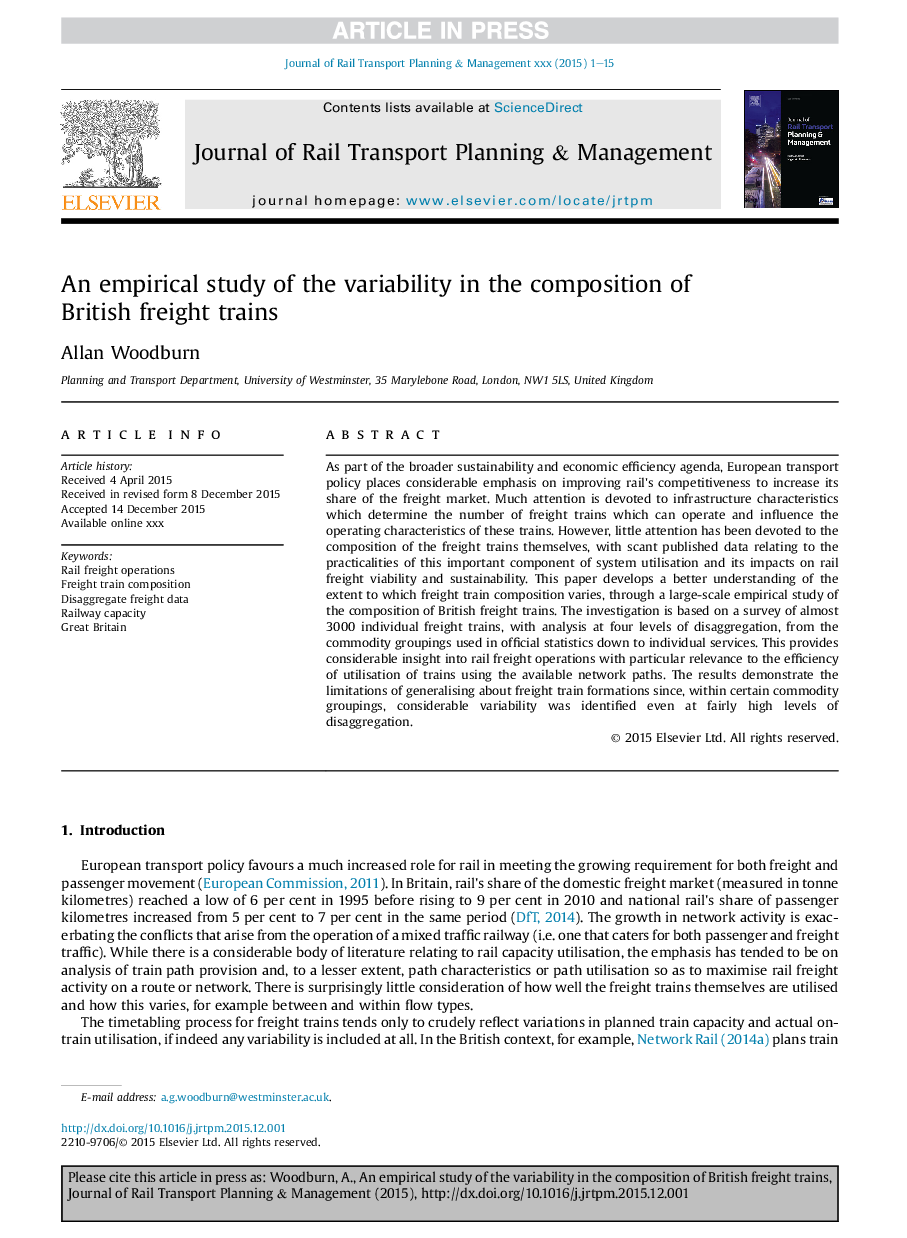| کد مقاله | کد نشریه | سال انتشار | مقاله انگلیسی | نسخه تمام متن |
|---|---|---|---|---|
| 10289162 | 509467 | 2015 | 15 صفحه PDF | دانلود رایگان |
عنوان انگلیسی مقاله ISI
An empirical study of the variability in the composition of British freight trains
ترجمه فارسی عنوان
یک مطالعه تجربی از تنوع در ترکیب قطار حمل و نقل بریتانیا
دانلود مقاله + سفارش ترجمه
دانلود مقاله ISI انگلیسی
رایگان برای ایرانیان
کلمات کلیدی
حمل و نقل ریلی، ترکیب قطار حمل و نقل، داده های بارگیری غیرقانونی، ظرفیت راه آهن، بریتانیای کبیر،
ترجمه چکیده
به عنوان بخشی از برنامه پایداری و برنامه ریزی اقتصادی کارآمد، سیاست حمل و نقل اروپایی تاکید زیادی بر بهبود رقابت راه آهن برای افزایش سهم خود از بازار حمل و نقل. توجه زیادی به ویژگی های زیربنایی اختصاص داده می شود که تعداد قطارهای حمل و نقل را تعیین می کند که می توانند بر ویژگی های عملیاتی این قطار کار کنند. با این حال، توجه کمی به ترکیب خود قطار حمل و نقل داده شده است، با داده های منتشر نشده در ارتباط با عملیات این بخش مهم از استفاده از سیستم و تاثیر آن بر زنده ماندن و پایداری حمل و نقل ریلی اختصاص داده شده است. این مقاله یک درک بهتر از اینکه میزان ترکیب ترکیبات قطار متفاوت است، از طریق مطالعه تجربی گسترده در مورد ترکیب قطار حمل و نقل بریتانیا، درک می شود. این تحقیق بر اساس یک نظرسنجی از تقریبا 3000 قطار حمل و نقل شخصی با تجزیه و تحلیل در چهار سطح تقسیم بندی، از گروه بندی کالا مورد استفاده در آمار رسمی به خدمات فردی است. این امر بینش قابل توجهی را در زمینه عملیات حمل و نقل ریلی با توجه خاص به بهره وری استفاده از قطارها با استفاده از مسیرهای موجود در شبکه ارائه می دهد. نتایج نشان می دهد محدودیت های عمومی در مورد تشکیلات قطار حمل و نقل، از آنجا که در برخی گروه بندی کالا، تغییرات قابل توجه حتی در سطح نسبتا بالا تقسیم بندی مشخص شد.
موضوعات مرتبط
مهندسی و علوم پایه
مهندسی کامپیوتر
نرم افزارهای علوم کامپیوتر
چکیده انگلیسی
As part of the broader sustainability and economic efficiency agenda, European transport policy places considerable emphasis on improving rail's competitiveness to increase its share of the freight market. Much attention is devoted to infrastructure characteristics which determine the number of freight trains which can operate and influence the operating characteristics of these trains. However, little attention has been devoted to the composition of the freight trains themselves, with scant published data relating to the practicalities of this important component of system utilisation and its impacts on rail freight viability and sustainability. This paper develops a better understanding of the extent to which freight train composition varies, through a large-scale empirical study of the composition of British freight trains. The investigation is based on a survey of almost 3000 individual freight trains, with analysis at four levels of disaggregation, from the commodity groupings used in official statistics down to individual services. This provides considerable insight into rail freight operations with particular relevance to the efficiency of utilisation of trains using the available network paths. The results demonstrate the limitations of generalising about freight train formations since, within certain commodity groupings, considerable variability was identified even at fairly high levels of disaggregation.
ناشر
Database: Elsevier - ScienceDirect (ساینس دایرکت)
Journal: Journal of Rail Transport Planning & Management - Volume 5, Issue 4, December 2015, Pages 294-308
Journal: Journal of Rail Transport Planning & Management - Volume 5, Issue 4, December 2015, Pages 294-308
نویسندگان
Allan Woodburn,
